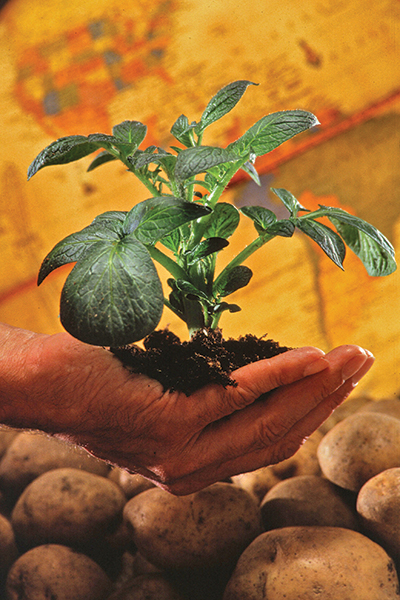JBC: A plant immune system corrects its course
Plant immune systems, like those of humans and animals, face a difficult balancing act: They must mount responses against ever-evolving pathogens, but they must not overdo it. Immune responses require energy and resources and often involve plants killing their own infected cells to prevent the pathogens from spreading.
 Researchers at labs in the UK and the Netherlands studied a receptor protein found in potato plants like this one that detects infection by a virus called potato virus X.Scott Bauer/USDA
Researchers at labs in the UK and the Netherlands studied a receptor protein found in potato plants like this one that detects infection by a virus called potato virus X.Scott Bauer/USDA
Researchers at in England have identified a crucial link in the process by which plants regulate their anti-viral responses. was published in the Journal of Biological Chemistry.
lab at Durham, in collaboration with the laboratories of at Wageningen University and at the University of Amsterdam, studied a receptor protein called Rx1, which is found in potato plants and detects infection by a virus called potato virus X.
Binding to a protein from the virus activates Rx1 and starts a chain of events that results in the plant mounting an immune response. But the exact sequence of cellular events — and how Rx1 activation was translated into action by the rest of the cell — was unknown.
“Our study revealed an exciting, and unexpected, link between pathogen attack and plant DNA,” Cann said.
Specifically, the study showed that Rx1 joins forces with a protein called Glk1. Glk1 is a transcription factor, meaning it binds to specific regions of DNA and activates genes involved in cell death and other plant immune responses. The team found that when Glk1 bound to virus-activated Rx1, it was able to turn on the appropriate defense genes.
When the viral protein was absent, Rx1 seemed to have the opposite effect — actually keeping Glk1 from binding to DNA. In this way, it prevented an inappropriate immune response.
“The immune response involves reprogramming the entire cell and also often the entire plant,” Cann said. “An important part of this regulatory process is not only allowing activation but also making sure the entire system is switched off in the absence of infection.”
More than one-third of the potential global crop harvest is lost to pathogens and pests each year, so breeding plants with better immune systems is an important challenge. Understanding how this immune system is regulated at the appropriate level of activity gives the researchers more ideas of points in the immune signaling pathway that could be targeted to increase the plant’s baseline ability to resist disease.
“To increase (crop) yield, there is an urgent need for new varieties that are resilient to these stresses,” Cann said. “A mechanistic understanding of how plants resist or overcome pathogen attack is crucial to develop new strategies for crop protection.”
Enjoy reading ASBMB Today?
Become a member to receive the print edition four times a year and the digital edition monthly.
Learn moreGet the latest from ASBMB Today
Enter your email address, and we’ll send you a weekly email with recent articles, interviews and more.
Latest in Science
Science highlights or most popular articles

ApoA1 reduce atherosclerotic plaques via cell death pathway
Researchers show that ApoA1, a key HDL protein, helps reduce plaque and necrotic core formation in atherosclerosis by modulating Bim-driven macrophage death. The findings reveal new insights into how ApoA1 protects against heart disease.

Omega-3 lowers inflammation, blood pressure in obese adults
A randomized study shows omega-3 supplements reduce proinflammatory chemokines and lower blood pressure in obese adults, furthering the understanding of how to modulate cardiovascular disease risk.

AI unlocks the hidden grammar of gene regulation
Using fruit flies and artificial intelligence, Julia Zeitlinger’s lab is decoding genome patterns — revealing how transcription factors and nucleosomes control gene expression, pushing biology toward faster, more precise discoveries.

Zebrafish model links low omega-3s to eye abnormalities
Researchers at the University of Colorado Anschutz developed a zebrafish model to show that low maternal docosahexaenoic acid can disrupt embryo eye development and immune gene expression, offering a tool to study nutrition in neurodevelopment.

Top reviewers at ASBMB journals
Editors recognize the heavy-lifters and rising stars during Peer Review Week.

Teaching AI to listen
A computational medicine graduate student reflects on building natural language processing tools that extract meaning from messy clinical notes — transforming how we identify genetic risk while redefining what it means to listen in science.

.jpg?lang=en-US&width=300&height=300&ext=.jpg)